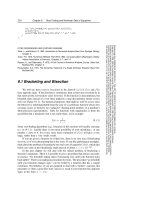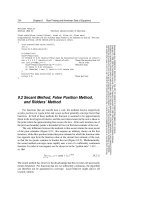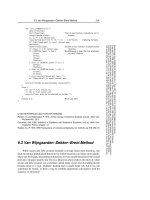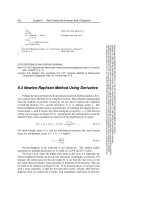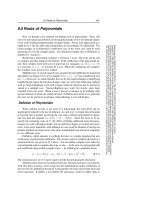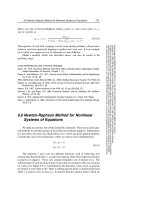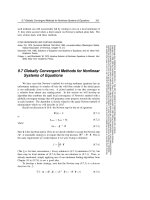Tài liệu ASME CODES AND STANDARDS EXAMPKES OF USE FOR MECHANICAL ENGINEERING STUDENTS pptx
Bạn đang xem bản rút gọn của tài liệu. Xem và tải ngay bản đầy đủ của tài liệu tại đây (1.83 MB, 20 trang )
Student Broc1a/apr03 10/14/03 10:10 AM Page 1
Dear Mechanical Engineering Student:
The articles in this booklet explore different facets of ASME Codes and
Standards. Written by eight ASME experts, they were originally published
in ASME Mechanical Advantage, a periodical for tomorrow’s engineers.
ASME Codes and Standards play an important role in ensuring the safety
of the public and in the standardization of things as common as nuts
and bolts. We have selected the articles to draw your attention to some
important aspects of your professional life as future mechanical engineers.
For an overview of ASME Codes and Standards, see the “Codes and
Standards at a Glance” section, which immediately follows the articles.
We hope that you find this collection interesting and informative, and
that it provides you with a new window into the field of ASME Codes
and Standards. Please let us know what you think at:
Sincerely,
Task Group on ASME Codes and Standards for Mechanical Engineering
Faculty and Students
Gerard G. Lowen, Chair
Stuart Brown
Domenic A. Canonico
Ryan L. Crane
John H. Fernandes
Philip M. Gerhart
Halit M. Kosar
Richard Merz
Sam Zamrik
For more information on ASME Codes and Standards, ask your faculty
adviser to show you the video “Introduction to ASME Codes and Standards”
and its companion booklet.
Student Broc1a/apr03 10/14/03 10:10 AM Page 2
1
ASME’s Role in the Globalization of
Codes and Standards
by Don R. Frikken, P.E.
Having one global standard becomes more and more important as companies
merge across international boundaries, helped by regional trade agreements
such as the North American Free Trade Agreement (NAFTA) and those estab-
lished by the European Union (EU), which have facilitated
international mergers through the lowering of tariffs on
imports.
The companies involved in these consolidations, used
to selling to just one market, now find themselves sell-
ing to global markets. The standards for products in
these markets are often different, which complicates
manufacturing procedures. Local laws may require the use
of a particular standard, yet these laws are viewed by the
World Trade Organization (WTO) as technical barriers to trade, and WTO mem-
ber countries are charged with reducing these and other barriers to free global
trade.
What is the best way for standards-developing organizations like ASME and for
users of standards to find a solution? Possible approaches are to adopt the
dominant standard, or to develop an umbrella standard that references other
regional and national standards, or to develop a global consensus standard
from scratch. ASME is involved in helping promote whichever approach best
serves a specific industry and the users of the applicable ASME standards.
ASME standards have changed over the last few years to include new con-
struction materials, to address new topics, and to incorporate new calculation
methods. As these changes continue to be introduced, globalization brings
even more change, requiring greater flexibility and adaptation from industry.
Student Broc1a/apr03 10/14/03 10:10 AM Page 1
2
Elevators, Escalators, and Moving Walkways
by Jim Coaker
How many times in the past week have you ridden in an elevator, on an esca-
lator, or on a moving walk? These actions are so routine in everyday life that
they happen automatically and are too numerous to recall.
Behind each mechanism is a web of machinery, power sources, control sys-
tems, and redundant safeguards in both design and operation that deliver
safe vertical transportation without inci-
dent. ASME International’s Safety Codes
for Elevators and Escalators, Inspectors’
Manuals, Existing Installation
Requirements, Evacuation Guide, and
Electrical Requirements are one of the
largest areas covered by the Society’s
600 standards.
Elevator ridership in the United States is
conservatively estimated at more than
200 billion passenger rides per year, a
figure that makes it easy to appreciate the critical role that codes and stan-
dards play in public safety. Dynamic change defines the world of technical
applications and ASME’s standards are constantly updated to keep abreast of
changes in technology.
Starting with basic design principles relating to public safety, these codes
and standards establish guidelines and requirements for equipment design,
installation, operation, inspection, and maintenance. Even if the end result is
invisible—a normal convenience in everyday life functioning without incident—
the underlying complexities of the system present stimulation and challenge to
the engineering mind. Some professionals spend their careers in this industry.
The next time you ride an elevator or escalator, remember the engineers who
have dedicated their careers to giving you a safe arrival!
Student Broc1a/apr03 10/14/03 10:10 AM Page 2
3
What are Performance Test Codes?
by Philip M. Gerhart, Ph.D. and Sam J. Korellis, P.E.
ASME Performance Test Codes (PTC) provide rules and procedures for planning,
preparing, executing, and reporting performance tests. A performance test is an
engineering evaluation; its results indicate how well the equipment performs its
functions.
Performance Test Codes originated as “Power Test Codes” and emphasized
energy-conversion equipment. The first ASME Code was Rules for Conducting
Boiler Tests, published in 1884. Today, nearly 50 PTCs are available; they cover
individual components (steam generators, turbines, pumps, compressors), sys-
tems (flue gas desulfurization, fuel cells), and complete plants (cogeneration
plants). In addition to equipment codes, supplements on instruments and appa-
ratus cover measurement systems (temperature, pressure, flow) and techniques
(uncertainty analysis) common to several codes.
For more than a century, ASME PTC tests have pro-
vided results with the highest level of accuracy,
based on current engineering knowledge and prac-
tices, and taking into account the costs of the tests
and the value of the information obtained. All
ASME codes are developed using input from a
range of parties, who may be interested in the
code and/or in the associated equipment or
process. Codes have the force of a legal docu-
ment when cited in contracts, as they frequently
are, for determining the method by which equipment performs as guaranteed.
PTCs are used by equipment owners, equipment suppliers, and test engineers.
ASME PTCs protect users from poorly performing products and enable suppliers
to compete fairly by offering reliable products. Purchase specifications are great-
ly strengthened by citing the results of PTC tests. When buying new equipment,
purchasers may specify that the equipment guarantee will be based on the
results of a specific ASME PTC test. Design engineers consult PTC documents
to ensure that proper instrument connections will be available. Test engineers
install the required instrumentation and use the code’s procedures and calcula-
tion methods to conduct tests on the new equipment. Representatives of all par-
ties to the test ensure that the test methods are in compliance with the code.
Finally, the test results are compared to the performance criteria.
Sometimes manufacturers and suppliers want to determine the exact perform-
ance of their equipment to understand the design margins or the effects of man-
ufacturing tolerances on performance. In this case, code tests are conducted
outside of any performance guarantees.
To ensure that ASME PTCs best serve global industries, additional products and
services always are being evaluated. As the preeminent provider of standardized
methods for performance testing; monitoring; and analysis of energy conversion
and industrial processes, systems, and equipment, ASME continues to develop
and add new codes.
Student Broc1a/apr03 10/14/03 10:10 AM Page 3
A Look at ASME’s Boiler and
Pressure Vessel Code (BPVC)
by Domenic Canonico, Ph.D.
The ASME Boiler and Pressure Vessel Code (BPVC) is a standard that provides rules
for the design, fabrication, and inspection of boilers and
pressure vessels. A pressure component designed
and fabricated in accordance with this standard will
have a long, useful service life, and one that ensures
the protection of human life and property. Volunteers,
who are nominated to its committees based on their
technical expertise and on their ability to contribute
to the writing, revising, interpreting, and administering
of the document, write the BPVC.
The idea for the BPVC arose in 1911 out of the need for
public safety, following the invention of the steam engine in
the late 18th century. Throughout the 19th century there were thousands of boiler
explosions in the United States and Europe, some of which resulted in many deaths.
The first Boiler and Pressure Vessel Code (1914 edition) was published in 1915; it was
one book, 114 pages long. Today there are 28 books, including twelve dedicated
to the construction and inspection of nuclear power plant components and two Code
Case books. (The 2001 edition of the Boiler and Pressure Vessel Code is more than
16,000 pages.) The 28 books are either standards that provide the rules for fabricating
a component or they are support documents, such as Materials (Section II, Parts A
through D), Nondestructive Examination (Section V), and Welding and Brazing
Qualifications (Section IX). Code Cases provide rules that permit the use of materials
and alternative methods of construction that are not covered by existing BPVC rules.
The BPVC is the largest ASME standard, both in size and in the number of volunteers
involved in its preparation. At any one time there are more than 800 volunteers
serving on one or more committees. The fact that the BPVC is a committee organ-
ized and administered by ASME may give the impression that the volunteers are
all mechanical engineers. This is not the case; to write such a standard requires
a breadth of knowledge that is not available in any one discipline. Volunteers on
the committees have expertise in materials (metallurgical and materials engineering),
structures (civil engineering), physics, chemistry (chemistry and chemical engi-
neering), and other disciplines in addition to mechanical engineering.
Various sections of the BPVC have been adopted into law in all the Canadian
provinces and in 49 of the 50 United States. More than one-quarter of the compa-
nies accredited by ASME Codes and Standards to manufacture pressure parts in
accordance with various sections of the BPVC are located outside of North America.
Internationally, the BPVC is recognized in more than 60 countries.
The record of the BPVC is a testament to its success. The safety record of pressure-
containing components manufactured in accordance with the rules of the BPVC is
outstanding. The contributions made over the past 90 years by thousands of volun-
teers, who have participated in the preparation of the BPVC, have made this possible.
4
Photo courtesy of the Nooter Corporation,
St. Louis, MO.
Student Broc1a/apr03 10/14/03 10:10 AM Page 4
5
U.S. Government Use of ASME Codes
and Standards
by Guy A. Arlotto
Your organization wants to construct and operate a nuclear power plant; to
supply the reactor steam supply system; to supply architect engineering services;
or to supply components (e.g., pressure vessels, piping pumps, valves) for a
nuclear power plant. The U.S. Nuclear
Regulatory Commission (NRC), the federal
agency responsible for issuing construc-
tion permits and operating licenses for
nuclear power plants, requires confor-
mance with certain ASME codes and
standards in its regulations. Therefore,
to obtain a construction permit or an
operating license, you must meet the
requirements of these codes.
In the 1980s the federal government’s
Office of Management and Budget (OMB)
first issued OMB Circular A-119, which
required certain government agencies
to use applicable national consensus
standards wherever practical, in lieu of
developing their own regulations to
accomplish their missions. More recently, a public law (PL 104-113)
mandates the use of national consensus standards, including ASME codes
and standards, by federal agencies where applicable. (The Dept. of Defense,
the U.S. Postal Service, and the U.S. Coast Guard routinely use them.)
The U.S. Atomic Energy Commission (AEC), NRC’s predecessor, did not need
the impetus of OMB A-119 or PL 104-113 to recognize the potential benefits
of using ASME codes and standards to work more efficiently and to ensure
public health and safety. A decade before OMB A-119 was first issued, the
AEC had already endorsed certain ASME codes in its regulations. In fact, AEC
involvement with the ASME codes and standards program dates from the mid-
1960s, when AEC staff began working on appropriate ASME code committees.
The use of nuclear power in the United States originated with the U.S. Navy
program to develop it as the power source for submarines. The Navy took it
further by applying it to surface ships and by demonstrating its potential for
land-based electrical power generation at the nuclear power plant at Shipping
Port, Pennsylvania.
Student Broc1a/apr03 10/14/03 10:10 AM Page 5
ASME recognized the need for enhanced codes and standards because the
technology was new and had no tested codes and standards available, and
because the consequences of component failures could have a serious impact
on public safety. It created a committee to develop design and construction
requirements to ensure the integrity, first of the reactor pressure vessel, and
then of other important pressure-retaining components. This resulted in what
is today called BPVC’s Section III. It covers an array of nuclear components,
including pressure vessels, piping, pumps, valves, supports, core support
structures, pressure relief, containment systems for spent fuel and high-level
waste transport packaging, and concrete components.
At the same time that Section III was being created by ASME in the late
1960s and early 1970s, the AEC was receiving applications monthly from
electric utilities in the United States for permits to construct nuclear power
plants. It was at that time that the AEC committed resources to the ASME
Codes and Standards program by supporting expert staff members to work
on ASME committees developing nuclear codes. This gave the AEC the confi-
dence to accept the finished code because its own staff had direct input in
the development of the requirements, and it understood the contents of the
code and the bases for the requirements. More important, the AEC decided
to endorse portions of ASME codes in its regulations, thus making it a require-
ment to satisfy the code as a condition for obtaining a construction permit.
Federal (AEC/NRC) regulations require first that one obtain a construction
permit allowing construction to begin. After construction is complete, the utility
must apply for and receive an operating license before beginning operation.
As nuclear power plants progressed from the construction phase to the oper-
ating phase, ASME developed and published Section XI, Rules for Inservice
Inspection of Nuclear Power Plant Components, to ensure that continued safe
operation was maintained over the life of the plant. This also was endorsed in
NRC regulations, making the periodic inspection and testing of components
and meeting acceptance standards a requirement for maintaining a license
to continue operation. This gives the NRC and the public a level of confidence
that any degradation of the plant during the period of operation has not
reduced safety below an acceptable level.
The NRC’s use of ASME codes and standards benefits ASME, the NRC, and
most important, the public. ASME’s codes and standards gain increased visi-
bility and stature through government use, its volunteers see the fruits of their
efforts, and public safety is maintained. The NRC benefits because by using
ASME codes, it can be a more efficient government agency, both in its deci-
sion-making and during various phases of the licensing process. The better
the NRC functions, the better the health and safety of the public is protected.
6
Student Broc1a/apr03 10/14/03 10:10 AM Page 6
7
ASME Codes and Standards in China
by John Ferguson
For several years The American Society of Mechanical Engineers has worked
to advance the use of ASME codes and standards in China, most notably,
standards for nuclear power plant equipment and for boilers and pressure
vessels. Beginning in October 2000, several successful workshops were held
in Beijing in cooperation with various Chinese organizations.
ASME’s goals are to have China’s nuclear
power plants, facilities, and associated
equipment designed and constructed to
ASME codes, and to have existing facili-
ties use ASME standards for operation
and maintenance. Chinese engineers
and regulatory personnel respect the
technical content of these codes and
standards and, in the absence of having
their own technical standards, have
expressed an interest in establishing
ASME standards as the standard for their nuclear programs.
In the last decade, ASME’s Boiler and Pressure Vessel Code (BPVC) has begun
to get wider use in China, and the Chinese government accepts imported
equipment constructed to its requirements. Greater use of the BPVC in the
construction of fossil-fuel-fired power boilers and in the petroleum and chemical
industries is being pursued.
With the increased use of ASME codes and standards in China, U.S. manufac-
turers and engineering service companies will have the opportunity to under-
take jobs and participate in the current expansion and new construction
taking place, particularly in the nuclear area. It also provides opportunities
for the sale of U.S made components. By having common technical require-
ments for equipment and services based on ASME codes and standards,
barriers to trade are reduced and public safety is enhanced.
Student Broc1a/apr03 10/14/03 10:10 AM Page 7
A Global Highway for Mechanical Engineering
Communications: ASME Y14.5, Dimensioning
and Tolerancing
by Lowell W. Foster
ASME Y14.5M-1994, Dimensioning and Tolerancing, which specifies engineering
drawing requirements, originated in the 1950s. Over the years it has incorpo-
rated technical innovations such as the new electronic compatible systems.
Its original goal was to delineate and define mechanical part hardware and to
create a common technical drawing language for standardized drawing prac-
tices. It was also recognized that repre-
senting a perfect part on the drawing
must include a permitted “tolerance”
as a deviation from the perfect part
(because perfection cannot be achieved
in real production). This explains the
dimensions and tolerances emphasis
of Y14.5M. This standard is designated
as an “Internationally Recognized
Standard,” the standard of choice
throughout much of the world.
ASME Y14.5M predominantly illustrates the Geometric Dimensioning and
Tolerancing (GDT) language to capture the “function and relationships” of part
features. This shows that the design requirements and dynamics of part fea-
tures (e.g., holes, pins, slots, surfaces), as they relate in part function, fit, or
assembly with mating parts, can be captured and specified with “geometric
characteristics,” “datum references,” and the other tools of the system. For
example, in a mating part situation where four pins on one part are to assem-
ble with four mating part holes, would it not stand to reason that if a hole (any
one of them and each individually) was produced away from its worst case low
limit size as an individual feature (i.e., be larger within its size tolerance), that
any permitted error (tolerance) of location of that hole could be increased an
equal amount? In other words, size of features can have an effect on, com-
pensate for, and assist in meeting the location tolerance. This is known as the
“maximum material condition” principle and increases possible location toler-
ances, brings down costs of production, and makes using functional gaging
principles possible, which ensures assembly and other advantages. The prod-
uct designer can select this option or decide on a more stringent method
(called “regardless of feature size”) when this dynamic is prohibited. Other
8
Student Broc1a/apr03 10/14/03 10:10 AM Page 8
9
controls delineate part form, orientation, profile, and location of features rela-
tive to design requirements. This is all done through the system’s symbolic
language and the rules and guidelines provided in the standard. This useful,
powerful, and widely recognized GDT language is now established as the best
method for communicating design requirements. Through use of the GDT
system, production, quality, inspection, tooling, programming, and all other
supporting operations can meet the requirements using a greater range of
methods.
Student Broc1a/apr03 10/14/03 10:10 AM Page 9
Cranes for Nuclear Facilities
by James E. Nelson
It would be difficult to overstate the importance of using the safest crane
design for handling heavy loads in nuclear facilities—it is critical. Dropping or
losing control of a load—a dreaded scenario—could result in damage to safe-
ty-critical equipment or spent fuel. It is unthinkable and it is impermissible.
With this in mind, the ASME Committee
on Cranes for Nuclear Facilities (CNF) has
written standards for overhead cranes,
the equipment that handles the majority
of heavy loads.
The Committee on Cranes was estab-
lished in 1976, shortly after the U.S.
Nuclear Regulatory Commission (NRC)
first issued written guidelines for safety-
critical or single-failure-proof (SFP) cranes.
In 1980, the committee's scope was
broadened from nuclear power plants
to nuclear (and other critical load han-
dling) facilities. Its first standard, ASME
NOG-1, Rules for Construction of
Overhead and Gantry Cranes, was
issued in 1983. The committee’s
second standard, NUM-1, Rules for Construction of Cranes,
Monorails, and Hoists, followed in 1996. Committee members represent a
range of power plant and nuclear facility owners and operators, engineers, reg-
ulatory personnel, constructors, equipment suppliers, and crane manufacturers.
No other industry or government standards have addressed important issues
for nuclear facility cranes such as quality assurance, dynamic seismic analy-
sis, and SFP crane features. NOG-1 and NUM-1 cover all of these and more.
In a Nuclear News magazine article,
1
NRC Commissioner Jeffrey Merrifield
said, “I believe that the future of the nuclear industry does not hinge on cor-
porate decisions about new plants, it hinges on the safety of
the existing fleet of reactors,” and “Anyone who believes that safety and
economic value are mutually exclusive goals is simply blind to the realities
that history has unmistakably, and sometimes painfully, taught this industry.”
Today, construction of new nuclear plants in the United States is being encour-
aged and numerous operating plants are applying for operating life extensions.
A heavy load drop would be disastrous for the industry, even without an offsite
release of radioactive materials.
10
Student Broc1a/apr03 10/14/03 10:10 AM Page 10
11
The NRC defines a heavy load as anything weighing more than a nuclear fuel
assembly (approximately one ton). A spent fuel cask can weigh 100 to 150
tons or more, and if dropped into the spent fuel pool, it could cause serious
damage to the pool and/or the fuel, resulting in a radioactive release.
Dropped elsewhere, it could damage safe shutdown equipment or rupture the
cask itself. The empty hook block on such a crane can weigh four or five tons
and can itself cause severe damage if it falls into the fuel pool or onto safety-
related equipment.
The NRC identified two primary causes of load drops as being severe types of
overload: "two blocking" or "load hangup." Two blocking occurs when control
malfunction or maintenance error permits unintentional overhoisting, resulting
in solid contact between the hook block and the head block or its supporting
structure. Immediate failure results with the wire rope and the dropping of the
load or empty hook block.
Load hangup is abrupt snagging of the moving load, resulting in similarly severe
effects on the equipment. Other causes of dropped loads include "mis-reeving"
of the hoist wire rope and failure of the hoisting machinery itself.
The NRC guidelines for SFP cranes, as well as ASME NOG-1 "Type I" and NUM
"Type I" SFP standards, specify cranes to be designed either to withstand all
such incidents without damage or loss of load, or to make the likelihood of
their occurrence extremely small. Type I NOG-1 and NUM-1 crane standards in
particular incorporate design requirements specific to these concerns, and
well beyond the requirements of other crane standards.
The work of the CNF Committee of ASME and the application of its standards
has never been more relevant. In the last few years there has been a tremen-
dous increase in the handling of spent fuel casks to move fuel from plant fuel
pools to independent spent fuel storage installations. Many operating plants
have reached or are approaching the time when they must remove spent fuel
from their pools in order to continue operation, but have delayed making heavy
load handling (crane) decisions. Now the need is imminent. In the handling of
spent fuel, both operating plants and decommissioning plants face many of
the same issues.
1
”Safety: The foundation upon which economic value is built,” Nuclear News, August 2001.
Student Broc1a/apr03 10/14/03 10:10 AM Page 11
Codes and Standards
Why are there codes and standards ?
The Industrial Revolution profoundly changed the way people lived by introduc-
ing machinery that transformed daily life. Farm implements no longer had to
be made by hand—they could be manufactured. Affordable manufactured
goods of all kinds would transform home life—textiles, dishware, reading
material. A coal-burning furnace and boiler could heat the water in your home.
Transportation began to move at unimagined speeds, far exceeding that of a
horse. Slowly, handmade items were being replaced with manufactured items;
human strength and horsepower were being replaced by machinery driven by
steam power—steam engines, boilers.
Because it’s a catastrophe when a screw doesn’t fit.
The most serious problem facing 19th century engineers was exploding boil-
ers. Heating water to produce steam and converting that steam into energy to
power machinery revolutionized the production of goods. To build up pressure,
steam must be contained in some type of vessel; but uncontrolled, pressur-
ized steam can burst a vessel even if it’s made of steel. For want of reliably
tested materials, secure fittings, and proper valves, boilers of every descrip-
tion, on land and at sea, were exploding with terrifying regularity. (They would
continue to do so into the 20th century.) Although engineers could take pride
in America’s strides in technology, they could not ignore the 50,000 dead and
2 million injured annually by such accidents. Thus, mechanical engineers in
the 1880s began seeking reliable methods for testing steam boilers.
Lack of interchangeability was also becoming a problem. A consumer couldn’t
buy a bolt in California and use it on a nut acquired in New Jersey because
the threading didn’t match. Therefore, the farm implement, shotgun, or pipe
was rendered useless, unreliable, or dangerous.
When The American Society of Mechanical Engineers (ASME) was founded in
1880, discussion began immediately on establishing standards; it focused on
shop drawing symbols, pulleys, line shafting, machine screws, key seats, and
drawing boards. At its annual meeting in 1883, a committee on standards and
gages was created and a paper was presented urging the adoption of a set of
rules for conducting boiler tests that could be accepted as a standard code of
practice by engineers. The paper emphasized the prevailing lack of uniformity
in which “every engineer who performs a boiler test makes a rule for himself,
which may be varied from time to time to suit the convenience or interests of
the party for whom the test is made.”
2
12
at a Glance
Student Broc1a/apr03 10/14/03 10:10 AM Page 12
The result was the formation of a committee to study the subject of a uniform
test code. In 1884 a test code for boilers was published; it was ASME’s first
standard. (Establishing a universally accepted construction standard would
still take many years.) Shortly thereafter, the Society decided that pipes and
pipe threads should also be standardized. The composition of this standards
committee was “men representative of pipe manufacturers and pipe users,
with perhaps one representative of sprinkling systems and certainly one of the
manufacturers of taps and dies.”
3
This balanced approach to committee com-
position became the norm for subsequent ASME standards committees.
2
The American Society of Mechanical Engineers, “Introduction to ASME Codes and
Standards” (New York: The American Society of Mechanical Engineers, 2000). Unattributed
source.
3
See note 1 above.
What is a standard?
A standard can be defined as a set of technical definitions and guidelines that
function as instructions for designers, manufacturers, operators, or users of
equipment. Depending on the subject, a standard can run from a few pages to
hundreds of pages, and is written by professionals in a particular technical
field, who serve on an ASME committee.
Standards, not having the force of law, are considered voluntary and serve as
guidelines. ASME publishes standards and accredits users of standards to
ensure that they are capable of manufacturing products that meet those stan-
dards. It also provides stamps that accredited manufacturers affix onto their
products to indicate that a product was manufactured according to the particu-
lar standard. ASME cannot, however, force any manufacturer, inspector, or
installer to follow ASME standards. Their use is voluntary.
Why then are standards effective? The 1991 Annual Report of the American
Society for Testing and Materials (ASTM) said it best: “Standards are the vehi-
cle of communication for producers and users. They serve as a common lan-
guage, defining quality and establishing safety criteria. Costs are lower if pro-
cedures are standardized; training is also simplified. And consumers accept
products more readily when they can be judged on intrinsic merit.” A standard
may also be incorporated into a business contract.
What is a code?
A standard is a code when it has been adopted by one or more governmental
bodies and is enforceable by law, or when it has been incorporated into a
business contract.
13
Student Broc1a/apr03 10/14/03 10:10 AM Page 13
What is the involvement of ASME in codes and standards today?
Since its creation in 1880, ASME and many other standards-developing organi-
zations have worked to produce standards through a voluntary consensus
process as the need for them increased. In addition to developing standards,
ASME provides conformity assessment processes for use in industry. These
help ensure both that manufacturers comply with equipment specifications
and that personnel are properly trained in specialized equipment operation.
ASME, ASTM, and the Society of Automotive Engineers (SAE) are three of the
more than 200 volunteer organizations in the United States that follow the
procedures accredited by the American National Standards Institute (ANSI) for
the development of standards. These procedures must reflect openness,
transparency, balance of interest, and due process.
ASME is one of the oldest and most respected standards-developing organiza-
tions in the world. It produces approximately 600 codes and standards, cover-
ing many technical areas, such as boiler components, elevators, measure-
ment of fluid flow in closed conduits, cranes, hand tools, fasteners, and
machine tools.
How does ASME produce codes and standards?
ASME’s Council on Codes and Standards oversees six standards-developing
supervisory boards and three advisory boards, which manage more than 100
committees and 3,600 volunteer members (see figure on next page). The
supervisory boards are responsible for pressure technology, nuclear installa-
tions, safety codes, performance test codes, conformity assessment, and
standardization. The advisory boards deal with international standards,
hearings and appeals, and council operations.
ASME formed the Codes and Standards Technology Institute (CSTI) in November
2001 to ensure that ASME standards committees are provided with a continu-
ing source of research in the technologies that they cover. CSTI provides the
research and technology development needed to establish and maintain the
technical relevance of codes and standards. CSTI has its own Board of Directors,
which also reports to the Council on Codes and Standards. Visit the CSTI web
page at www.csti.asme.org for more information.
A request for a code or standard may come from an individual, a committee,
a professional organization, a government agency, an industry group, a public
interest group, or from an ASME division or section. First, the request is
referred to the appropriate supervisory board for consideration. The board
assigns the request to an existing committee or determines that a new stan-
dards committee must be formed. Once a committee has concluded that there
is enough interest and need, the standards development process begins.
14
Student Broc1a/apr03 10/14/03 10:10 AM Page 14
15
COUNCIL ON
CODES
AND STANDARDS
BOARD ON
PERFORMANCE
TEST CODES
BOARD ON
SAFETY CODES AND
STANDARDS
BOARD ON
CONFORMITY
ASSESSMENT
CODES AND
STANDARDS
TECHNOLOGY
INSTITUTE
BOARD ON
STANDARDIZATION
BOARD ON
PRESSURE
TECHNOLOGY, C&S
BOARD ON
NUCLEAR CODES
AND STANDARDS
BOARD ON
INTERNATIONAL
STANDARDS
BOARD ON
HEARINGS AND
APPEALS
BOARD ON
COUNCIL
OPERATIONS
Student Broc1a/apr03 10/14/03 10:10 AM Page 15
16
The standards committee is composed of engineers and other interested par-
ties with knowledge and expertise in a particular field. They represent users,
manufacturers, consultants, academia, testing laboratories, and government
regulatory agencies. The committee maintains a balance of members among
the various interest classifications so that no one group dominates.
Committee volunteers agree to adhere to the ASME Policy on Conflict of
Interest and the Engineer’s Code of Ethics.
Committee meetings must be open to the public, and procedures are used to
govern deliberations and voting. All comments on technical documents during
the approval process must be considered. Any individual may appeal any
action or inaction of a committee relating to membership, or a code or stan-
dard promulgated by the committee.
Content is approved through consensus voting as defined by ANSI. Balloting is
conducted at standards committee meetings and votes are also sent by mail
and email; members can even review ballots and submit their votes online on
ASME’s Web-Based Process Management System ().
Repeated voting may be necessary to resolve negative votes. If an individual
member feels that due process was not observed, appeals may be made to
the standards committee, supervisory board, and finally, to the Board on
Hearings and Appeals.
Once consensus is reached, the proposed standard in draft form is submitted
to a public review online. Anyone may submit comments during the public
review period, to which the committee must respond. The draft is also submit-
ted for approval to the supervisory board and to ANSI. When all comments
and considerations have been satisfactorily addressed, the document is
approved as an American National Standard and published by ASME. But the
work doesn’t end there; codes and standards are living documents that are
constantly being updated, revised, and reissued to reflect new developments
and technical advances.
Conclusion
Televisions, computers, hand tools, medical devices, elevators, boilers—virtu-
ally all modern mechanical devices involve one or more engineering standards
in their manufacture. ASME is one of several professional and technical organ-
izations that work together to maintain the machinery of the modern world.
The fact that the general public is unaware of their work is the best tribute to
the success of their achievement—bringing stability to the systems of daily
life through the production of voluntary codes and standards.
Student Broc1a/apr03 10/14/03 10:11 AM Page 16
Student Broc1a/apr03 10/14/03 10:11 AM Page 17
The American Society of Mechanical Engineers
Three Park Avenue, New York, NY 10016-5990
CS0103
Student Broc1a/apr03 10/14/03 10:11 AM Page 18

